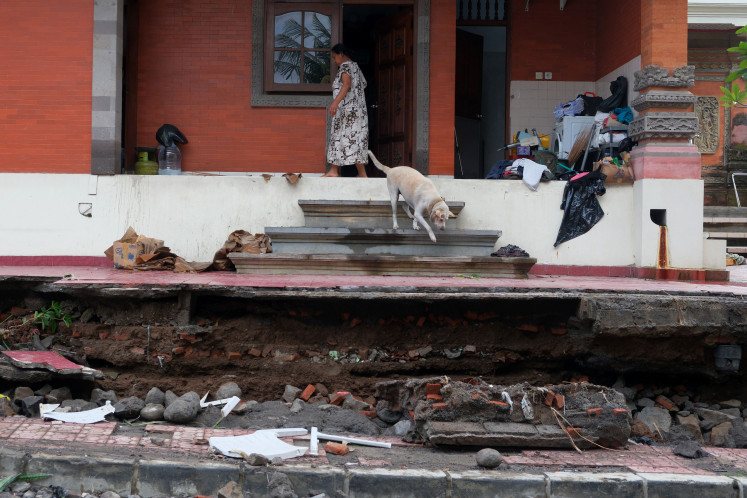Popular Reads
Top Results
Can't find what you're looking for?
View all search resultsPopular Reads
Top Results
Can't find what you're looking for?
View all search resultsIndonesia fails in tobacco control measures
Change text size
Gift Premium Articles
to Anyone
A
myriad of inspirational, beautiful and manipulative commercial messages from the tobacco industry greet Indonesian children and youths every day through various channels.
Most models in cigarette ads appear as “cool, creative and attractive figures,” something these youths are always dreaming of.
All cigarette ads placed in outdoor settings, mainstream and social media, apply sophisticated marketing savvy to make tobacco use and smoking appealing to smokers and potential smokers. These companies continue sponsoring sports, art, music concerts of youth idols and even school activities aimed at directly targeting their potential users.
Indonesia is a paradise for tobacco companies, which produced 341 billion sticks nationwide in 2017.
They have persistently preyed on soft targets – children and adolescents, who are still in the early cognitive development stages. These efforts seem to have paid off with a high number of adolescents aged between 10-18 already active smokers.
The 2018 Basic Health Survey (Riskesdas) revealed that the share of smokers among people aged 15 years and above was 33.8 percent in 2018, the highest in the world. The smoking prevalence among males was 62.9 percent; among females it was 4.8 percent.
The most alarming trend is in children aged 10-18, where the share of smokers increased from 7.2 percent in 2013 to 9.1 percent in 2018. The total number of active smokers has reached 67 million out of a 270 million population.
WHO data reveal that tobacco kills 225,720 Indonesian people every year, or about 700 per day.
Fasli Jalal, professor of public health and rector of YARSI University, said the high number of smokers, especially among children and adolescents, was a national and global embarrassment for Indonesia.
“On the global public health stage, the Indonesian government is seen as an ‘enabler’ by allowing our children and youth to smoke cigarettes and nontobacco [products] freely, without strict legal protections,” the professor said on the phone.
Indonesia is the only country in the Asia Pacific region and one of just a few countries worldwide not to have signed the WHO’s Framework Convention on Tobacco Control (FCTC).
The FCTC, adopted by WHO member countries in 2003, requiring members to impose a comprehensive ban on tobacco advertising, promotion and sponsorship. Currently, it has 168 signatories and 181 parties, excluding Indonesia.
Jalal continued it was disturbing to see children smoking cigarettes as they were copying their fathers and adults as role models. Being exposed to cigarette ads within their surrounding was also a significant factor, he said.
“Across the archipelago, you see so many children under 10 years of age already smoking cigarettes,” the professor lamented.
Smoking was associated with various diseases, the professor said, adding that extensive evidence showed the negative impacts of smoking and tobacco use on lung health.
“These child and youth smokers already have unhealthy respiratory conditions. They are not ready to go through the COVID-19 pandemic. I am so concerned,” he said.
Smoking was also detrimental to the immune system and its responsiveness to infections, making smokers more vulnerable to various infectious diseases, including SARS, MERS and now COVID-19, he added.
“The COVID-19 outbreak could become a defining moment, for the government to seriously enforce tobacco control in order to protect our future generation,” he said.
Jalal’s strong call for stricter tobacco control is widely supported by more than 40 associations in Indonesia, including public health expert associations, tobacco control activists, consumer protection and child protection CSOs in a series of tweets addressed to President Joko “Jokowi” Widodo since early April.
Hasbullah Thabrany, professor of public health at the University of Indonesia, agreed it was high time for Indonesia to become a “smoke-free country” by enforcing strict limits on the promotion of tobacco use.
“Tobacco control requires full public participation, self-discipline and communal discipline. It is the responsibility of the government at all levels, academia, public health professionals, schools, parents and the communities and most of all the tobacco industry,” the professor said, adding that personal and social behavior played a crucial role.
“The Indonesian people mostly lack self-discipline. During the current COVID-19 outbreak, I have visited numerous densely populated areas in Jakarta, and I have found so many people still smoking their cigarettes, ignoring their health as well as that of others,” he said.
He was contrasting Indonesia’s COVID-19 response to that in neighboring countries like Singapore and Vietnam.
“The people of these countries are very disciplined, and law enforcement is also effective,” he said.
Thabrany, together with Ahmad Ansyori and Citra Yulianti, has assessed the impact of the high prevalence of smoking in Indonesia on medical expenditure.
Their study, entitled The Political Battles of Tobacco Control and NCDs in Indonesia, estimated the economic loss at about three to four times the government’s revenue from the tobacco excise.
“It is misleading to accept any argument that the tobacco industry helps the country and its people financially. It has more disadvantages than benefits,” Thabrany explained.
The study states that medical expenditure due to tobacco-linked diseases and the loss of productivity in 2015 totaled Rp 595.56 trillion (US$45 billion).
Meanwhile, tobacco excise revenue in 2015 was only Rp 140 trillion ($10 billion). The revenue of Phillip Morris Indonesia in 2017 was Rp 99 trillion ($7.4 billion), which compares to the Ministry of Health’s 2017 budget of Rp 54 trillion ($3.9 billion), the study reveals.
“The study was conducted when the public health and economic situation in Indonesia was normal. Now, during the COVID-19 crisis, the results would be more dismaying,” he said.











